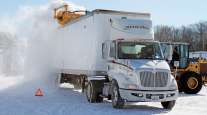Historic Blizzard Freezes Traffic, Disrupts Shipping on East Coast

Winter Storm Jonas set snowfall records on the East Coast, wreaking havoc from South Carolina to Massachusetts, leaving truckers stranded and claiming 48 lives.
The Jan. 22-23 blizzard dumped more than 3 feet of snow in some places.
Trucks were temporarily banned from the Pennsylvania Turnpike on Jan. 22, and the speed limit for all other vehicles was lowered to 45 mph, after a slew of trucks jackknifed once snow fell between exits 110 and 146.
West Virginia was walloped by 42 inches of snow, leading to more than 150 trucks strewn on Interstate 77 in Charleston and preventing entry to I-79. That prompted Gov. Earl Ray Tomblin to call in the National Guard.
“We had a lot of issues with trucks on the interstates because [Department of Highways] wasn’t able to keep up with snow removal so trucks had nowhere to park,” West Virginia Trucking Association President Janet Vineyard said.
Temporary hours-of-service exemptions were granted to certain haulers in the Carolinas, Tennessee, Virginia and West Virginia as part of emergency declarations in those states.
In North and South Carolina, drivers received waivers if they were aiding in utility restoration and debris removal or carrying essential fuels, food, water, medical supplies, livestock and poultry, as well as feed for those animals. Size-and-weight limits also were raised to 90,000 pounds, 75 feet long, and 12 feet wide.
Virginia’s declaration was nearly identical. Tennessee’s exemption covered food haulers, while West Virginia’s covered propane haulers.
Washington, D.C., took the brunt of Jonas, which paralyzed the metropolitan area throughout its cleanup. The federal government remained shut down Jan. 25-26, as were Pennsylvania and Virginia state governments.
Cleanup efforts were helped by plenty of advance warning from government agencies and weather forecasters to stay home Jan. 23-24 so some roads were passable by Jan. 26.
However, deliveries by UPS Inc., FedEx Corp. and the U.S. Postal Service still were spotty in Washington, D.C., Baltimore and Richmond, Virginia.
“We have developed flexible contingency operations through the years that allow us to adapt to these challenges,” said Jim Masilak, spokesman for FedEx, which ranks No. 2 on the Transport Topics Top 100 list of the largest U.S. and Canadian for-hire carriers. “Our flexibility includes the ability to adjust flight schedules and redirect flights, as well as enlist additional trucks to supplement our transport capabilities.”
No. 1 UPS had partial service disruption in 13 states and Washington, D.C., early on, but most routes were back to normal by Jan. 26.
“We were fortunate that the storm hit on the weekend with reduced volume and operations,” said UPS spokeswoman Susan Rosenberg.
No. 3 J.B. Hunt said it had to shut down many operations over the weekend in Maryland, New Jersey, North Carolina and Pennsylvania and let its customers know that delays of 24 to 48 hours were possible as the company restored full service.
Gov. Andrew Cuomo banned traffic in New York City and Long Island, which were deluged with far more than the expected 7 inches, to give Department of Transportation crews time to clear the roads. The Port of New York and New Jersey partially reopened Jan. 26.
Overall, state DOTs and trucking associations were pretty pleased.
Pennsylvania Motor Truck Association CEO Jim Runk said that he hadn’t received a complaint about the temporary truck ban on his state’s turnpike.
Maryland State Highway Administration spokesman Charlie Gischlar added: “Most areas got 2 feet of snow and many got more, but we were able to keep one passable lane open for emergency vehicles on the interstates except for I-70 between I-695 and I-81, a distance of about 65 miles, as well as the entire length of I-270 between the Capital Beltway, I-495 and I-70.”
The state had 10-hour overnight shutdowns, he said. “We spent a week letting people know that it was going to be a dangerous storm. The forecast was right on this time so a lot of people heeded the advice and stayed home. They didn’t go out on Saturday for safety and on Sunday to let us clear the roads.”
New York State Motor Truck Association President Kendra Hems said the weekend storm helped her members more easily adjust their schedules and stay off the roads.
New Jersey Motor Truck Association Executive Director Gail Toth said the state’s DOT did a fine job of clearing and maintaining the main freight routes, especially the New Jersey Turnpike, despite the 2 feet of snow that was unexpectedly dumped on the Garden State, causing near whiteouts.
In neighboring Delaware, Lee Derrickson, executive director of the Delaware Motor Transport Association, said his members were in catch-up mode Jan. 25-26 after wisely parking their trucks over the weekend, but were still encountering some rural driveways that made jobs very difficult.
“Mother Nature may try, but we pride ourselves on not closing roads,” said Gene Donaldson, manager of the Delaware Transportation Management Center, who had to briefly shut down Route 1 along the coast because of flooding. “You work on planning, being prepared and being able to respond.”
Staff Writer Daniel P. Bearth contributed to this report.


